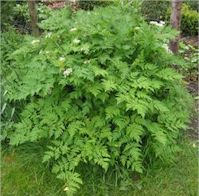 |
"There is found," writes Parkinson, "during June and July, in almost every English hedge, a certain plant called Choerophyllum, in show very like unto Hemlockes, of a good and pleasant smell and taste, which have caused us to term it 'Sweet Chervill.'" And in modern times this plant has taken rank as a pot herb in our gardens, though its virtues and uses are not sufficiently known. "The root is great, thick and long, exceedingly sweet in smell, and tasting like unto
anise seeds. This root is much used among the Dutch people in a kind of loblolly or hotchpot, which they do eat, calling it warmus. The seeds taken as a salad whilst they are yet green, exceed all other salads by many degrees in pleasantness of taste, sweetness of smell, |
and wholesomeness for the cold and feeble stomach." In common with other camphoraceous and strongly aromatic herbs, by reason of its volatile oil and its terebinthine properties, the Scandix, or Sweet Chervil, was entitled to make one of the choice spices used for composing the holy oil with which the sacred vessels of the Tabernacle were anointed by Moses. It belongs to the particular group of umbelliferous plants which is endowed with balsamic gums, and with carminative
essences appealing powerfully to the sense of smell.
The herb Chervil was in the mind of Roman Catullus when discoursing sweet verses of old to his friend Fabullus:
"Nam unguentum dabo quod meoe puelloe
Don?nt veneres, cupidinesque.
Quod tu quum olfacies deo rogabis
Totum ut te faciat. Fabulle! nasum."
"I will give you a perfume my damsels gave me,
Sweet daughters of Venus, sad hoydens are ye!
Which the moment you smell will incite you to pray
My Fabullus! to live as 'all nose' from that day."
Evelyn taught (1565) that "the tender tops of Cherville should never be wanting in our sallets, being exceeding wholesome, and cheering the spirits; also that the roots boiled and cold are to be much commended for aged persons." But in 1745 several Dutch soldiers were poisoned by eating the rough wild Chervil, from which the cultivated sweet variety is to be distinguished by its having its stems swollen beneath the joints--much as our blue-blooded patricians are signalized by
gouty knuckles and bunion feet.
The botanical name of the Sweet Chervil (Choerophyllum) signifies a plant which rejoices the heart Kairei-phyllum. "The roots," said an old writer, "are very good for old people that are dull and without courage; they gladden and comfort the spirits, and do increase their lusty strength." The juice is slightly aperients, and abundantly lacteal when mixed with goat's milk, or in gruel. Physicians formerly held this herb in high esteem, as capable of curing most
chronic disorders connected with the urinary passages, and gravel. Some have even asserted that if these distempers will not yield to a constant use of Chervil, they win be scarcely curable by any other medicine. The Wild Chervil will "help to dissolve any tumors or swellings in all parts of the body speedily, if applied to the place, as also to take away the spots and marks in the flesh and skin, of congealed blood by blows or bruises." The feathery leaves of Chervil, which
are of a bright emerald hue in the spring, become of a rich purple in the autumn, just as the objectionably carroty locks of Tittlebat Titmouse, in Ten Thousand a Year, became vividly green under "Cyanochaitanthropopoin," and were afterwards strangely empurpled by "Tetragmenon abracadabra," at nine and sixpence the bottle.
Herb Simples
The Primitive Simplers presented here show the way of life in other generations, it is not suggested or recommended trying them yourself. |
|
Garden
Herbs
Home
History of Herbs
Herb Gardening
Herbs for Beginners
Drying & Preserving Herbs
Indoor Herb Gardening
Herb Garden
Hints & Tips
Herbal
Cooking
Herb Chart
Using Herbs
Culinary Herbs
Herb
Oil and Vinegar
Herb Teas
Herb Candy
Herb Jelly
Herb Simples
Preface
Introduction
Alphabetical Listing

Trade
Recipes Online
Share your Recipes with others!!
|


